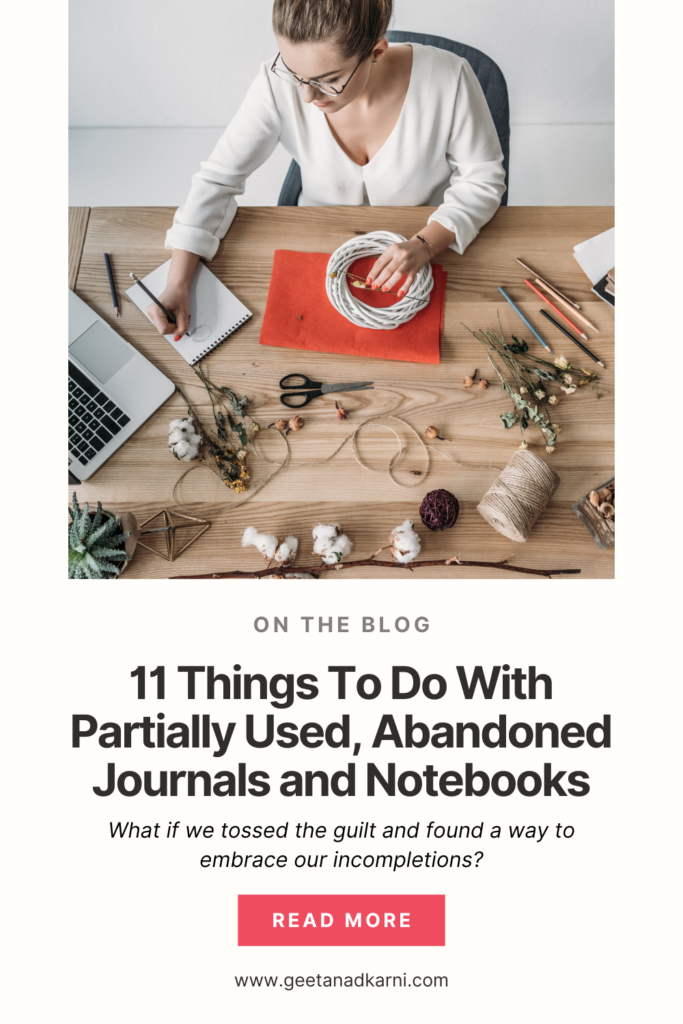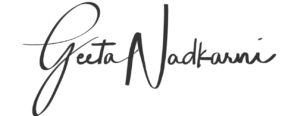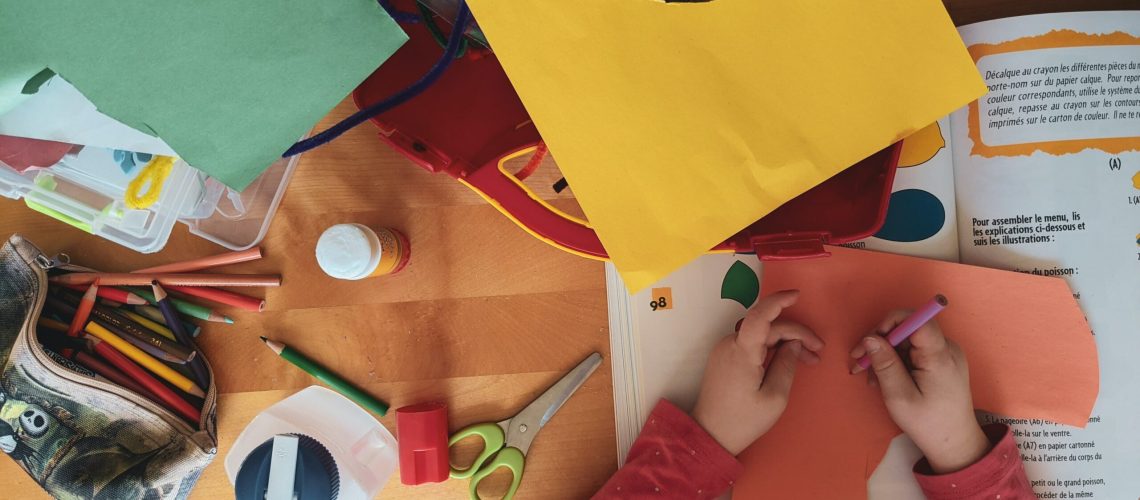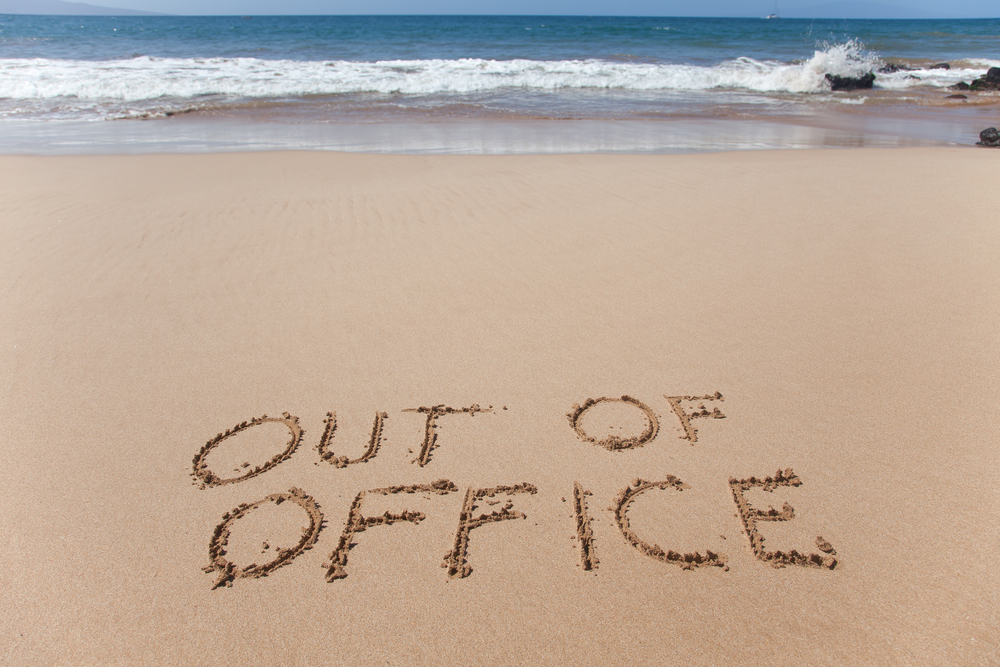I’ll admit it.
For years I had a guilty pile of partially used journals and notebooks that I’d bury under papers or tuck into the furthest corners of my bookshelves.
I experienced them as accusations. Proof of my waywardness and lack of follow through. My inability to do what I’d decided to do and follow some rigid process every single day.
I had gratitude journals, note-taking journals with partially completed summaries and reviews of books I was reading, various structured or guided journals, productivity-oriented planners and more.
And they all told the same sordid story of, “She was excited, she started, she got bored, she quit.”
Shame. Blame. Ugh.
Of course, my frugal nature also won’t let me just burn them or get rid of them or be okay with trying something new that ended up not being for me. “But a tree died for this,” my environmentally friendly, aspirationally minimalist inner critic hisses in her judgiest tone.
But in the last 2 years, I’ve come to be more flexible with how books get used in my life.
This isn’t just for journaling – I have actually stopped trying to fit into other people’s definitions of how I should read (“One book at a time” and “All the way to the end”) and now read up to 7 or 8 books simultaneously and take notes and connect ideas and fucking love every minute.

So here’s how I apply that same freedom and abundance mindset to using journals and notebooks.
I remind myself that journals are tools and tools can be used all kinds of different ways. The artist shouldn’t be victim to her tools – the tools are there to support the artist in making her art.
Shall I say “tool” again? No you’re a tool.
(okay, serious face)
So the very first thing to do is to examine any unconscious beliefs you have about the “right” way to use journals or notebooks.
There isn’t one.
So tell your stuffy Inner Critic to go lick a toilet seat and instead feel into this list for ways that might expand your enjoyment of the bounty you’ve collected.
- Give them to a child: I mean, what else are they good for (children I mean)? My extremely artistic 6-year-old is usually ecstatic to receive a partially used planner or leather-look journal to stick stickers in and cover in paint and stamps. I feel no need to police her “waste” (shameful to admit, I know, but my Inner Critic will boss everyone if I let her) because the whole process feels joyful instead of guilty. I have also made custom coloring pages for her with rude sayings and funny cat drawings that keep her busy while we’re waiting in a doctor’s office or at a restaurant.
If you don’t have kids yourself, reach out to friends with kids under 10 and you’ll likely have a bunch of takers. - Use them for meeting notes or to test pens/ calligraphy styles: I often use old, half complete notebooks and even the blank sections of planners like my beloved (but still half-finished) One Thing planner to scribble down ideas and to-dos while in meetings or while taking online classes. It’s a great way to keep my scribbles in a single “idea dump” until I can process or discard them. If you’re into fountain pens and inks or calligraphy, old notebooks can be excellent to test styles or colours.
- Make art over old gratitudes: I’ve been writing 1- 10 gratitudes per day for almost 4 years as of this writing. I talk about this in detail in my book How to Live Your Vision: Manifest Your Dream Reality in Less Than 15 Minutes Per Day. But doing this practice meant that, at one point, I had a stack of 5 gorgeous Peter Pauper Press journals with thousands of little grateful memories in them. I couldn’t bring myself to throw them in the recycling bin, so I was inspired to use them as a backdrop to art journaling. Creating collages while re-living grateful moments led to many happy hours of joyful self reflection. I imagine that making art over even breakup stories or difficult memories would be quite therapeutic.
- Rip and collage: Taking the art idea one step further, you could rip out pages from old journals and use them in collages and other forms of artwork. I fell in love with collage as an art form because there are no rules, the work is quick and dirty (which means I can be done with a project in a single 30 minute sitting) and messy is what you want.
If you don’t see the point of creating an art journal, you can also use the ripped pieces to create beautiful bookmarks or cards that make excellent one-of-a-kind gifts for grandparents and new friends. I often use these handmade bookmarks in place of business cards when I meet people at events and I want to truly deepen a relationship with them. - Rip and stick: I’ve had many a notebook that has reams of rubbish (defunct to-do lists and scattered thoughts) but some real nuggets. In situations like that, I will carefully tear out the “good” pages and either stick them in one of my current journals where I can use it as a topic to inspire deeper writing, or photograph it and stick it in my Evernote. Eventually, if the information is valuable enough, I’ll even type it up and use it in an article or one of my books.
- Rip and scrapbook: I have, on occasion ripped out lists of gratitudes and inserted them into a family scrapbook to add authentic flavor. It’s also fun to do a #throwbackthursday type scrapbooking spread where you compare what a day might have looked like 2 years ago based on your to-do lists or appointment schedule and what it currently looks like. Extremely fun when you’re comparing before and after kids or perhaps your schedule before and after leaving corporate.That said, even 10 years into being a full time business owner, no two years look anything alike.
- Rip and box: If you know the memories are special or fun enough to preserve but you don’t yet have a scrapbook or any sort of destination for them, you can also just curate a selection of pages that you store in a binder or shoebox. I’ve come to realize that the mundane becomes more magical with time. I would love to read my own grandmother’s daily to-do list or better still, her memories of key events in her life and her private reflections on them. I imagine my grandkids might find my own life a lot less mundane than I sometimes do.
- Make a notepad: Rip unused pages out of a notebook, stick on a bulldog clip or tuck into a clipboard and voila, you have a pad to keep on the kitchen counter for random notes and lists.
- Donate: Your local women’s shelter might happily accept partially used notebooks and other office supplies. Google yours to find out what they’re looking for and make your life lighter while giving someone else what they need.
- Junk journal: If you’re at all crafty and have never heard of junk journaling, you are in for a treat. Check out Joie de Fi, one of my fave junk journaling YouTubers, for loads of ideas, inspiration and free tutorials. It’s an incredibly fun activity to do solo and with kids.
- Zentangle: Inexplicably relaxing for many folks – especially neurodiverse ones – zentangle is an artform that you pretty much can’t mess up. It’s a shockingly simple process that involves drawing what end up being incredibly complex patterns and coloring them in. Here’s a tutorial from YouTube that beginners might enjoy.
Zentangles are fab for drawing while listening to an audiobook or while being on endless hold with the bank, for example.
So there you have it. 11 separate ideas for using your half finished notebooks to kickstart your creativity or generosity instead of using them to beat yourself up.
Loved this post? Consider sharing it with a fellow journal junkie who could use some help lightening their load and finding joy.





